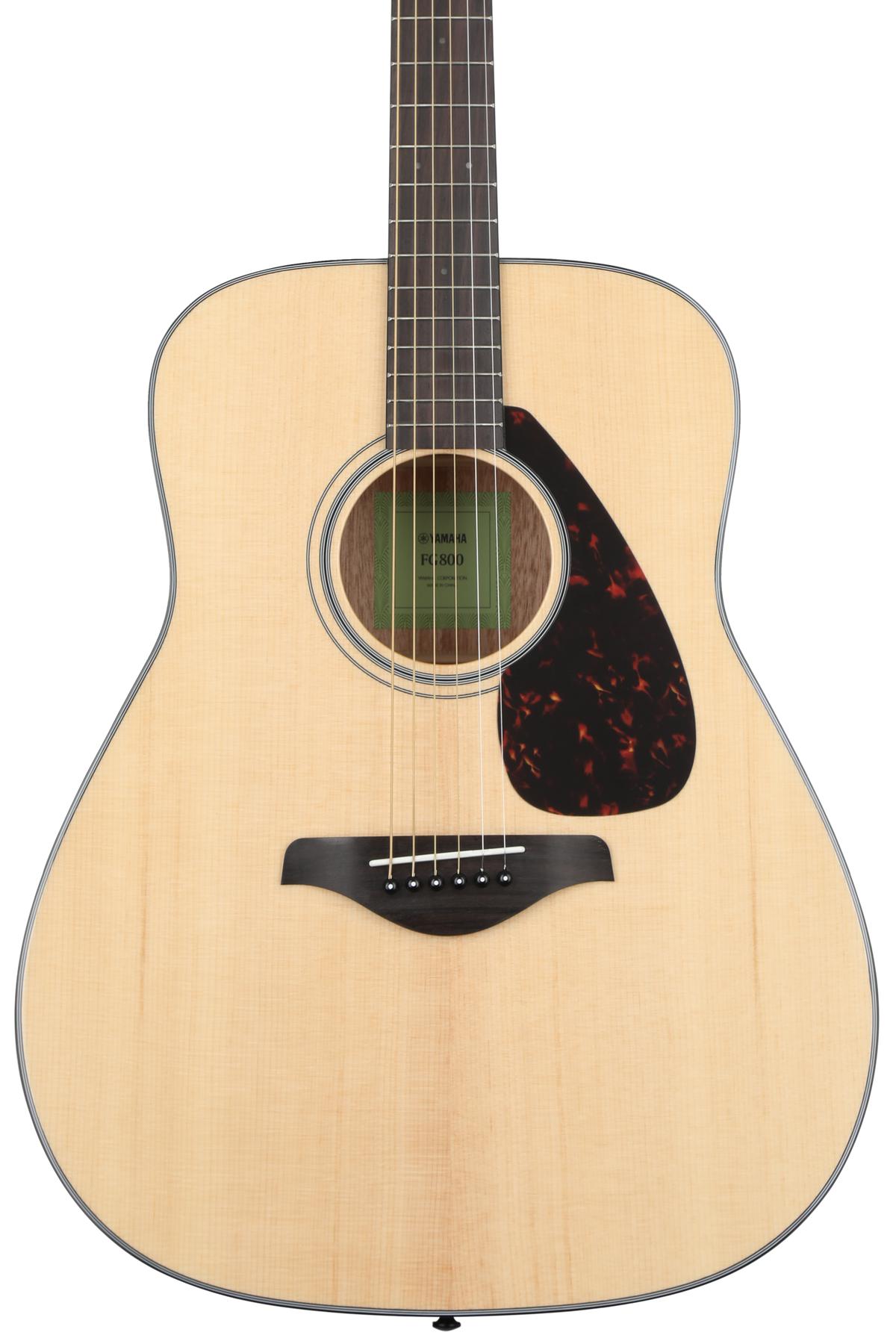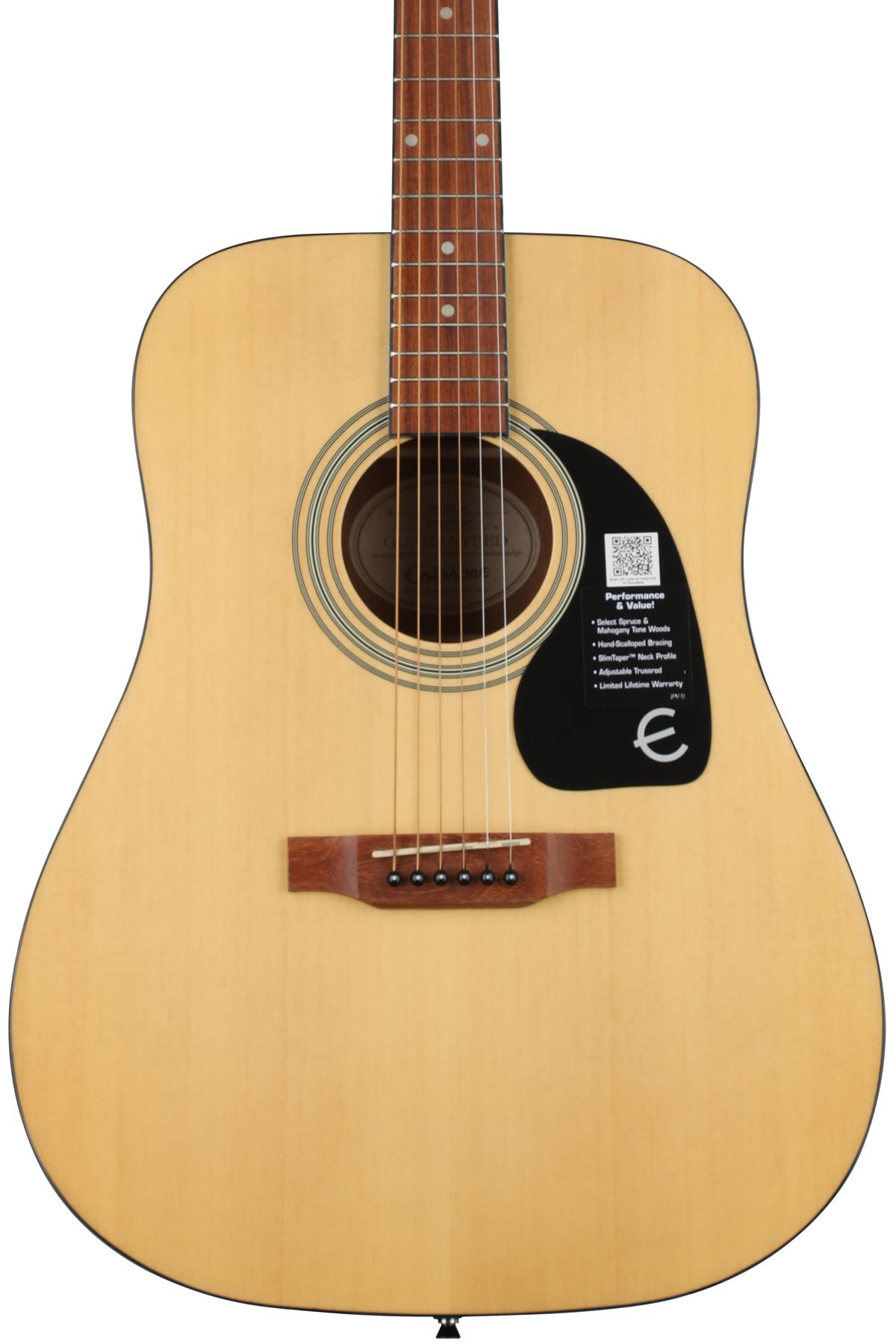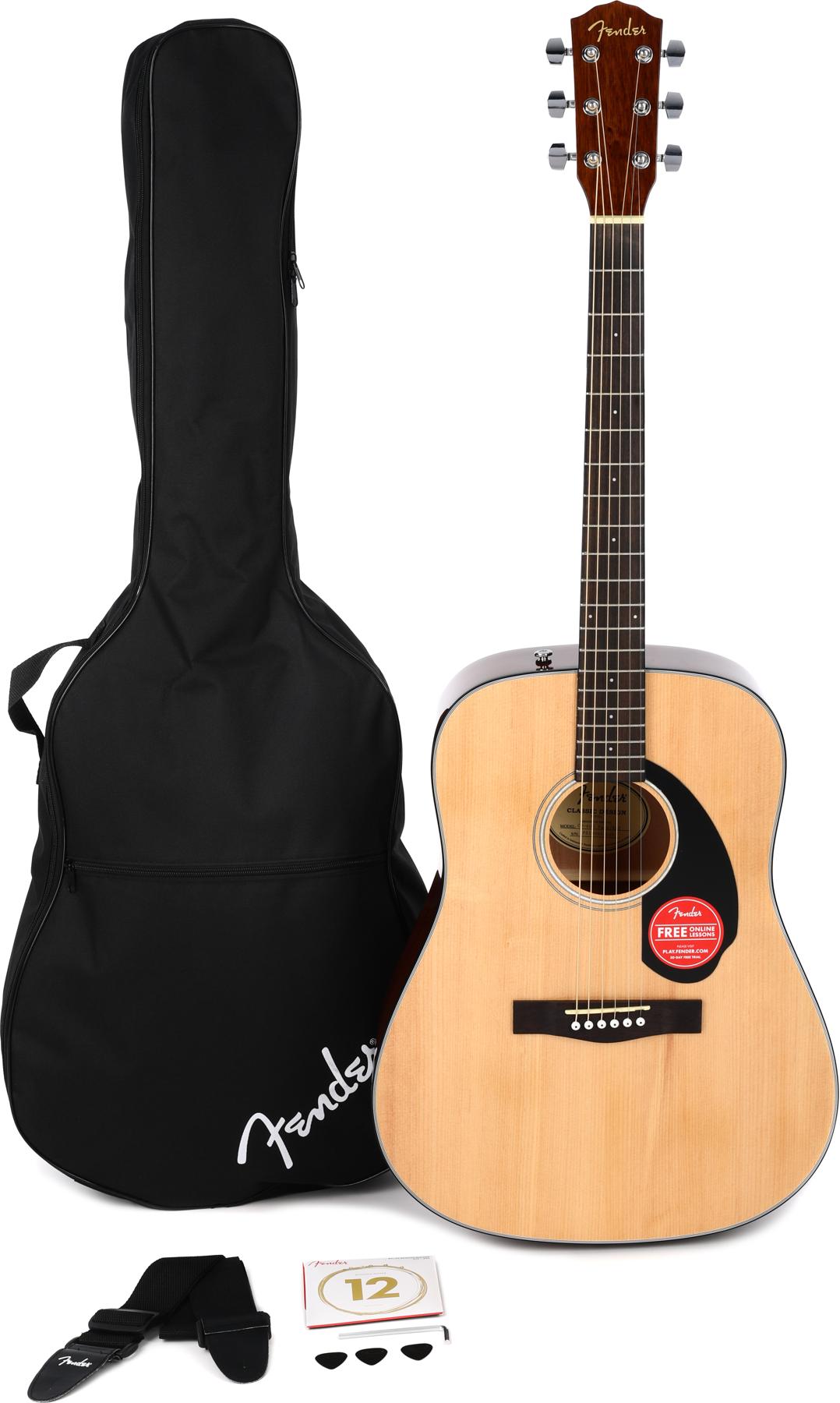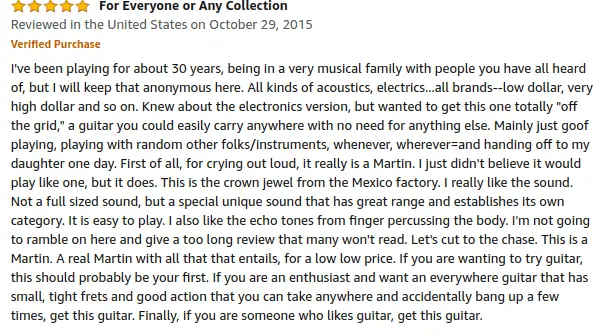If you're looking for an affordable, entry-level guitar that's uniquely suited to folk music, the Yamaha FG800 offers an attractive choice. It's often hard to find an entry-level guitar with a rich sound. After all, manufacturers have to cut corners somewhere when it comes to price, and all too often, those corners are cut where they shouldn't be: the prevalence of laminate-top beginner acoustics and poorly-made tuners are two glaring examples.
However, the instrument is a promising one for beginners and intermediate guitarists alike. With a solid top, balanced high-end and low-end sounds, scalloped bracing, and classic dreadnought looks, the Yamaha FG800 offers surprisingly good tone for the price. In this Yamaha FG800 acoustic guitar review, we'll delve into what sets this instrument apart.
Things To Consider Before Buying An Entry-Level Acoustic Guitar
If you're like most people shopping for an entry-level acoustic, your primary goal is to get something easy to learn on without breaking the bank. And while most beginner guitars won't have the dazzling sound of a professional-grade instrument, something that sounds decent is often much more rewarding to play. It's possible to find a beginner guitar that sounds good, but it may take some looking.
One widespread buying mistake when getting a beginner instrument is assuming that an entry-level acoustic made by a major manufacturer is automatically a better choice. And while these guitars aren't always an unfortunate investment, in many cases, you end up paying more for the brand name than you do for the guitar's features. As you shop, make sure you carefully read the specs of any beginner guitar you consider. One of the essential things for good sound is a solid (not laminate) top. And as you may have already found, plenty of major brands offer intro guitars with non-solid tops.
Our Picks for Review
Features and Benefits
While it's always a good idea to also do your research as you shop for guitars, the available information is sometimes overwhelming, especially if you're just starting. Here, we've gathered some of the critical features and benefits of the Yamaha FG800 Acoustic guitar.
Sound Quality And Tonewoods
The tonewoods used to construct a guitar is one of the primary considerations you want to make when buying. And while you can't expect all-solid woods or exotic tonewoods to be used in a budget instrument, the FG800 has surprisingly good construction for the price.
To start, it has a solid spruce top. A solid top is vital if you want a more vibrant tone and good sustain, and it's one of the critical things separating well-made acoustics from cheaper ones. While an all-solid instrument may sound slightly better, the top is where solid wood matters most.
When it comes to the back and sides on affordable acoustic guitars, many manufacturers choose excessively cheap laminates that negatively impact the guitar's tone. However, when it comes to the back and sides of the FG800, Yamaha strikes a great balance between sound quality and price. While some people might think of it as another no-name budget tonewood, Nato is often called "eastern mahogany" because it's similar in looks and sound to actual mahogany. Like mahogany, it has a mellow sound that balances out the brightness of the Sitka top. The tonewood makes it great for fingerpicking, Flatpicking, and folk music in general.
If you want to check out the FG800's sound for yourself, this video offers a great sound demo of the guitar in action.
Body And Neck Style
The FG800 is a full-sized dreadnought guitar. This body style is popular mainly because of its rich, full tone. It also features Yamaha's newly developed scalloped bracing. This internal design improves the guitar's projection and volume. Since many budget guitars are made with little thought given to bracing, this kind of attention to detail helps the FG800 stand out amongst similarly-priced models.
The Yamaha FG800 has a 43mm nut width, which is somewhat narrow. The narrow nut width is often a good thing, especially if you have smaller hands or are new to playing. Like the back and sides, the neck is made of nato, and its dark rosewood fingerboard adds a pleasing aesthetic touch. It's also smooth and easy for you to slide your fingers as needed. If you want to know more about the guitar's playability in general, this video review covers it in depth.
When it comes to style, the body is understandable--it has a natural, gloss finish and simple yet elegant black and white binding. If you want a guitar with a flashier abalone rosette or unique accents, you might not prefer this model. But if you value the classic look of a natural-finish dreadnought, this is a guitar that delivers great tone in a plain package. However, if you want something a little different, the FG800 also comes in a sleek black finish.
Tuning Heads, Saddle, Bridge, And Nut
One of the primary disadvantages of many entry-level guitars is that they tend not to have excellent tuning stability. Most of this is due to cheaply-made tuners. Luckily, one of the strengths of the FG800 is that it has die-cast tuners, which can remarkably increase tuning stability (they look nice, too). If you're curious, this video introduces die-cast tuners and some of their advantages. When it comes to hardware, the FG800 uses the same components as Yamaha's higher-priced FG830, so you can rest assured that the Yamaha fg800 comes standard with quality hardware.
The Yamaha has a rosewood bridge, which is relatively standard on natural-finished acoustics. The bridge adds an attractive accent to the FG800's relatively plain design. The nut and saddle are made of urea, which is Yamaha's plastic composite. A guitar's nut and saddle (and especially the nut) have an impact on tone. And as construction materials go, plastic isn't great. The Yamaha sounds surprisingly good even with the plastic saddle and nut. Still, you may want to upgrade to bone or Tusq (a patented composite that has many of the tonal advantages of ivory) down the line.
Purchasing Options
The Yamaha FG800 is somewhat unique in that you can buy it as part of a bundle, or as a standalone instrument. Some beginners prefer a bundle, as it allows them to get everything they need to start in one purchase. You can find the Yamaha FG800 in two bundles: one has just the guitar and a hardshell case, which is ideal if you want extra protection for your guitar.
You also can purchase the instrument in a beginner bundle with just about everything you need. This package is surprisingly affordable, as it's only a little more expensive than buying just the guitar. Here's what it comes with:
Social Proof of the Guitar
If you're fortunate enough to know a handful of experienced guitarists, you'll probably seek their input before buying. However, since many players (and especially those new to it) don't have a circle of people to ask, it's a good idea to read several online reviews before making your decision.
We've looked at several reviews of the FG800 and have found that buyers mostly had positive things to say. Here are three reviews that capture some of this guitar's strengths (as well as its shortcomings):
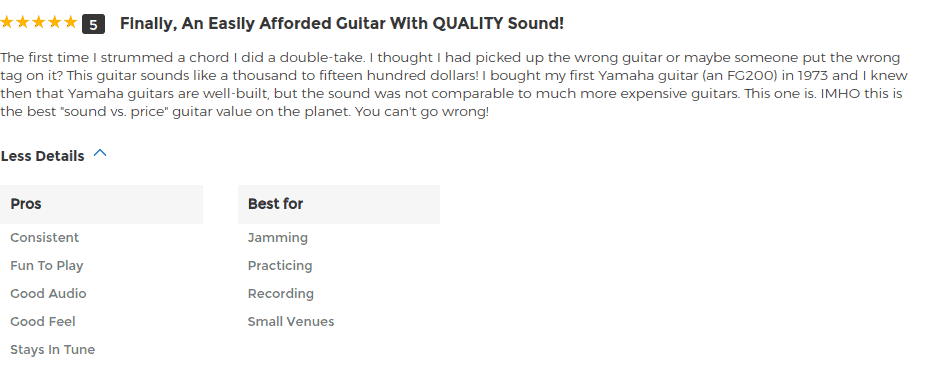
The above review captures what we also think is the FG800's best feature--its excellent sound quality for the price. Even if you can't try out this FG800 in person before buying, be sure to check out some of the sound demos linked above--we think you'll be pleasantly surprised, too.

This Yamaha FG800 review addresses a common concern with entry-level guitars--tuning stability. Many similar reviews say the same thing--that the guitar holds tune well, even with Yamaha's in-house tuners.

One concern with reading reviews of beginner guitars is that some players don't have anything to compare them to. This review is a useful one because the reviewer does have an instrument to compare it to. It's worth noting that, at $600, the Martin mentioned is on the lower-quality end. However, given that the FG800 stands up to a guitar that's worth three times as much, it's a useful piece of anecdotal data to consider.
Alternatives to Yamaha FG800
If you're a wise guitar shopper, you won't only buy the first decently-priced guitar you see. In this section, we've found three similar guitars you may want to compare to this one.
Fender Squier SA-150
How it Compares to Yamaha FG800
Review
Squier is Fender's budget brand, and this no-frills model may be a good choice if you're tight on cash. It's a full-sized dreadnought (and since a lot of beginner guitars are 3/4 sized, this is an essential feature in itself). However, its all-laminate construction leaves something to be desired.
Squier doesn't specify which laminates are used, likely because budget instrument makers often rotate wood choices depending on price and availability. If you're looking for something very inexpensive, this may be a good choice. But if you can save a little more money and buy something that at least has a solid top, you'll likely be more satisfied with your purchase in the end.
If you need a playable beginner instrument on a shoestring budget, this one might be worth checking out.
Epiphone DR-100
How it Compares to Yamaha FG800
Review
If you want a vintage-inspired dreadnought that comes in a range of colours, the Epiphone DR-100 might be a good choice. It's a bit cheaper than the FG800--Epiphone is Gibson's budget brand, and it tends to enjoy a better reputation than Squier among guitarists. However, like the SA-150, this model has a similar issue--it's made of all-laminate woods.
But unlike the SA-150, the woods used to make the Epiphone DR-100 are named. It has a spruce top and mahogany back and sides, meaning it may be somewhat similar in tone to the FG800. Plus, the instrument comes equipped with Epiphone's Slim Taper neck, making it easier for beginners and those with smaller hands.
If you want to save money but still want something with recognizable tonewoods, this is a guitar worth looking at.
Fender CD-60S
How It Compares To Yamaha FG800
Review
If you want an easy-playing, solid-top guitar at the same price point as the FG800, the Fender CD-60S is worth checking out. The "CD" in the name stands for "Classic Design," and this vintage-inspired instrument blends older-style design with a slimmer neck for easier playability. It also is unique when it comes to tonewoods.
This Fender CD-60S is made of all mahogany, which gives it a mellower sound with an emphasis on the midrange. Like the Yamaha, it has a solid top and laminate sides.
In Conclusion
Finding an affordable entry-level instrument that still offers excellent sound quality and playability is often a challenge. However, the FG800 delivers quality sound on a budget. And since Yamaha is known for producing quality instruments even at low prices, you'll be buying from a trusted manufacturer. With its solid top, excellent tuning stability, and balanced tone perfect for folk-style music, the FG800 is likely to be a guitar you'll be happy with for years to come.

